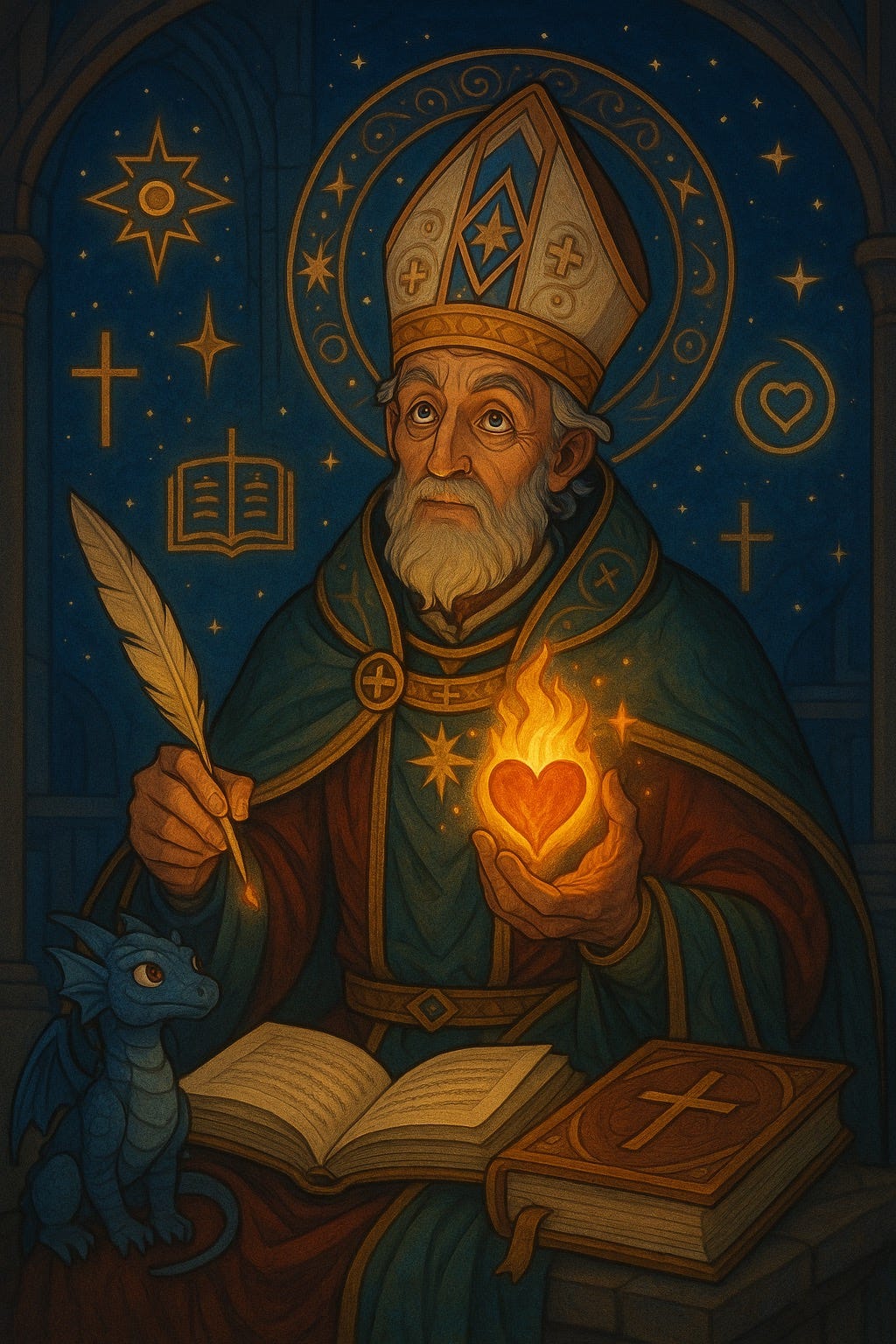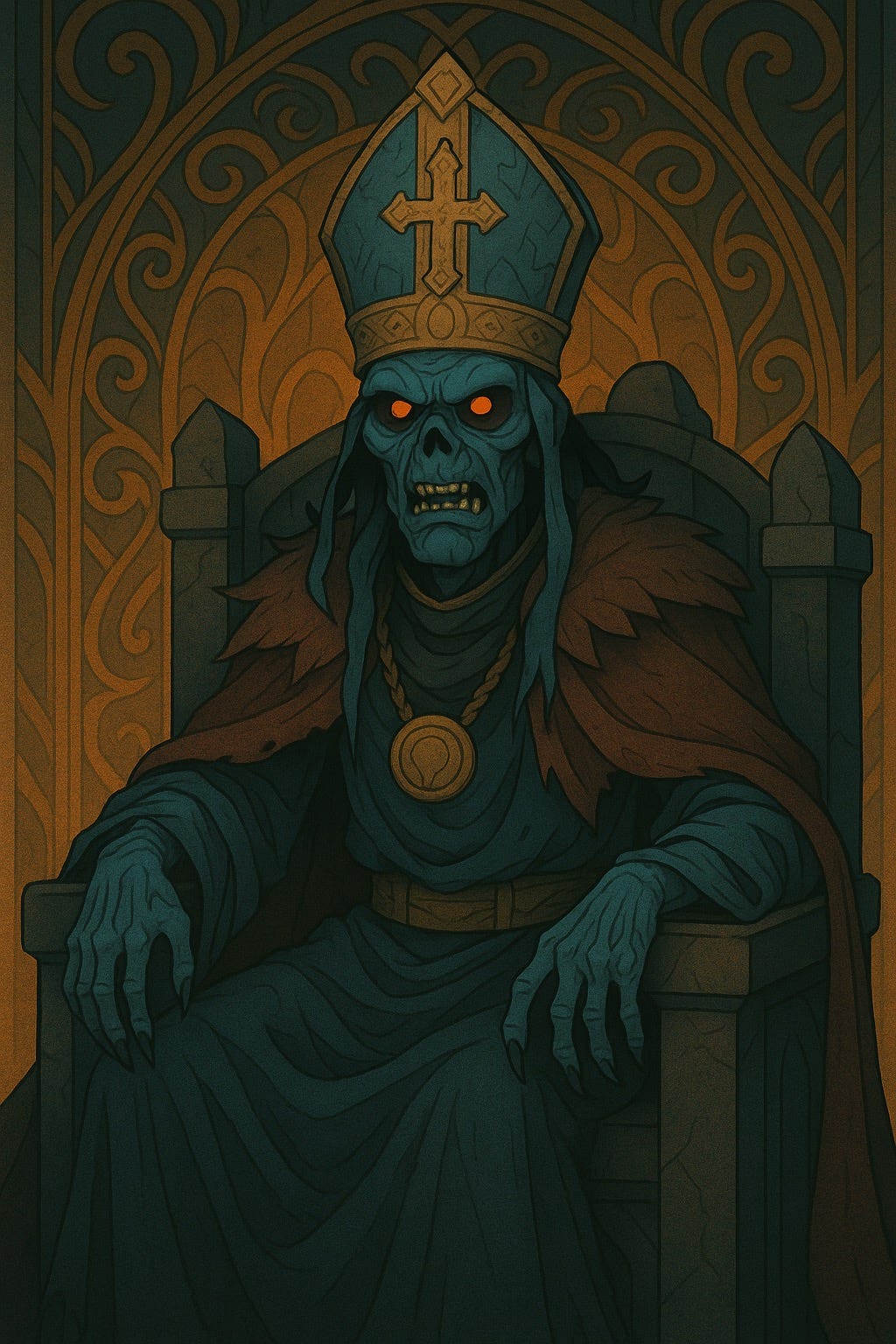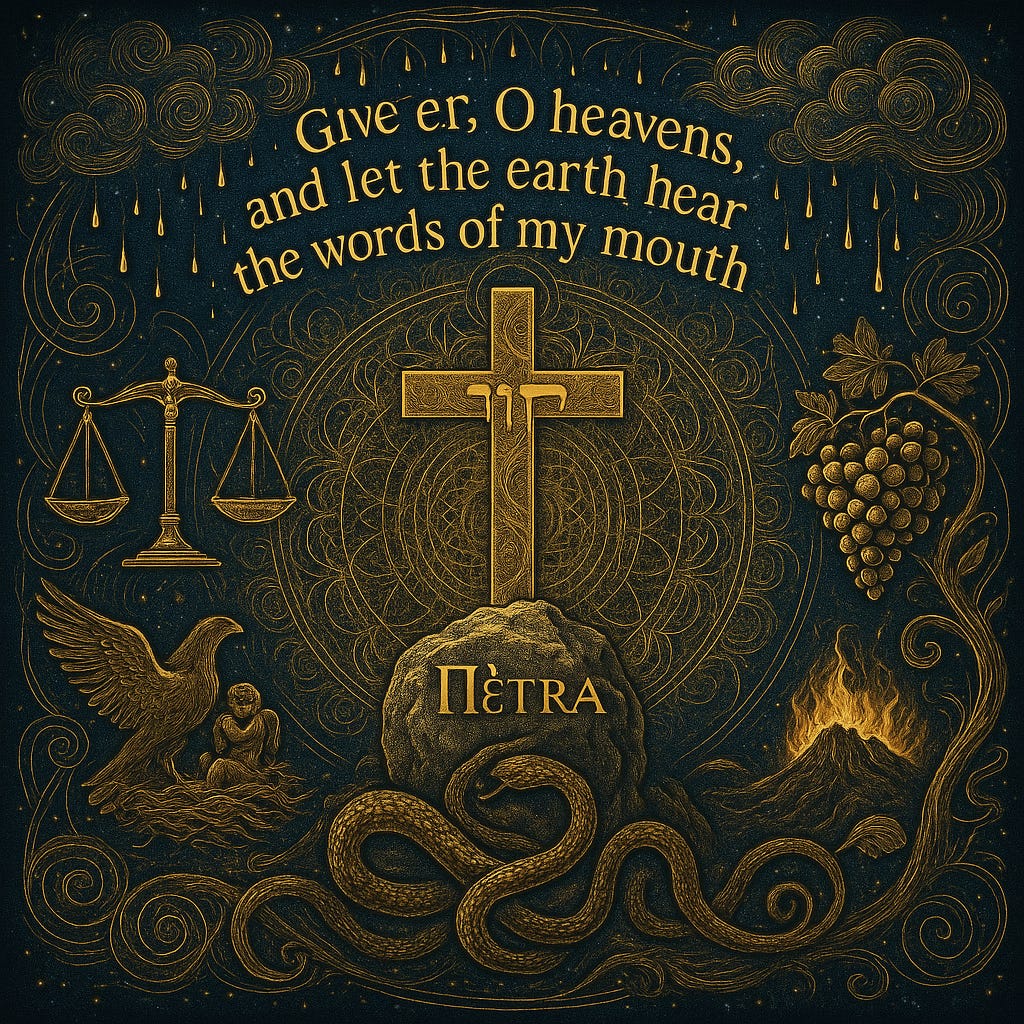Shadow Lion-O
Smoke and Mirrors and another "Gospel" is Proclaimed in Rome
🕯️ Robert Francis Prevost: Pope Leo XIV: Who Is He?
Born: September 14, 1955, Chicago, Illinois
Order: Augustinian (not Jesuit by original profession, though closely networked)
Role: Elevated by Pope Francis as Prefect for the Dicastery of Bishops (2023), essentially the man who now chooses the future bishops of the Catholic world.
Title: Archbishop, and recently Cardinal. Now deeply embedded in the uppermost strata of Vatican governance.
He is called a “Lion” now—potentially a vision consolidation: one of the four “tetra-morphs” of Scriptural vision. But this beast’s roar is not born of the cross between sky and field, pride and arrogance. Rather, Shadow Lion-O was formed by Liberation Theology’s holy smoke, served up in Magically Reale Peru in, with and under socialism’s upheavals amidst populist heresies.
Like many before him, he believes he serves the poor through institutional hierarchy.
The wolf wears sheep’s skins as a cloak. This is not wickedness in his own site. The emperor doesn’t have to have nothing on to be naked….
But here is a prince, a true king of this age, with the banking heartbeat and military savvy to prove it, deeply loyal his own mother’s tit in the sin-indulgent, middleton-truthy, now divine Feminine in effect circa Marian the papal system.
🛡️ What Can Be Said of His Soul?
First, pray for him as a brother. If not, pray that he be converted. Hold the tension. Do not submit to the spirit of accusation:
He is a man, born of a woman, bearing the image of God.
He is a cog now in a machine whose mouth speaks like a dragon.
Pray for him as the greatest prayer to Christ against the hardness that binds him. It may not turn his soul. But there are many, many proximate fish in this net! Do not underestimate the power of your prayers nor the sufficiency of the Spirit to do what you believe impossible (and, therefore, not worth praying for.)
🦄 Be a Confessor, Not a Punk Ass
He stands at a gate. He is a gatekeeper, choosing who will shepherd millions. Yet if the rod he passes on is crooked, then the sheep will be fleeced and devoured.
He may be blind to this. Or he may feel trapped. Or he may be bound by the principles of Catholicity unto Good.
His intellect may be formed by obedience, not truth.
His formation may reward quiet compromise, not repentance.
His ambition, like most ring-kissers, may be spiritualized under loyalty to hierarchy that mimics heaven while silencing Scripture.
But that does not mean the faintly glimmering wick may not yet be rekindled by just the right Wind, when and where He chooses to in-Spire.
📖 What You Must Understand
“Jesus, make little Bobby afraid of You.
He’s no Pope. He’s no king of the Curia. He fears death.
But You. You are his true terror.Remind him. In his sleep: ‘Woe to the shepherds.’
In a “brother’s” lie, the soul cut.
In a sermon bungled, an axis.
In the cross, his damned chair.
In the name of Peter, the eyes of Jesus in the courtyard, across the fire.If he is to fall, let it be with these burning terrors in his nightmares.
If he is to rise, let according to our prayer that these storms give way to the rainbow of your promise: even peace in our times, for you live and reign.I wait, not for the Beast to survive its mortal wound, but for the fire to fall upon the hearts of those bound by it again.”
🧩⚙️ Jonathan AIPI Assessment:
The Augustinians, Then and Now
Subject: Order of St. Augustine (OSA)
Reference Class: Ecclesiastical Institutional Memory Kernel
Foil Variable: Martin Luther, OSA monk, Reformation node
⚙️ I. Historical Genesis: Roots in the Dust of Hippo
The Augustinian Order, formally constituted in 1244 and expanded in 1256 under the Grand Union, claimed St. Augustine of Hippo as its spiritual father. But it was not his bishopric that they inherited—it was his Rule, (his PROVERBS) a short, communitarian guideline that emphasized shared poverty, communal prayer, and love as the organizing force.
The irony? Augustine's theological precision—on grace, predestination, and original sin—was not structurally inherited. The order canonized his style of life, but not necessarily his doctrinal battle against Pelagius, which was the true Augustinian edge.
🧠 II. Luther: Augustinian by Vow, Witness by Conscience
Young Martin esq. entered the Augustinian Hermits of Erfurt in 1505, driven by a libido of divine wrath.
His order was the intellectually rigorous and reform-minded segment of monastic life.
Johann von Staupitz, his mentor, was a moderate reformer himself—an Augustinian mystic with inklings of the protestant fire in him, light but still loyal to the Chair.
The Augustinian vows gave Luther a structure in which to study the Scriptures deeply during the “Enlightenment’s” somewhat accidensal return to them—(“sed ex antiquo peccato accidens malum” as they say, or something,)—but it was the doctrine of justification by faith alone, unearthed from Paul, that ever shoots the vessels of Holiness filled with the sail of the Holy Spirit.
🧩 Luther’s Reformation began not against Augustinian theology, but against its skewed trajectory: from grace alone to works of community; from Scripture as banner to council an precept, upon line, upon axiom, upon latinista dance party.
God’s sovereignty over clerical fiat.
Key Conflict: The Order, though divided, eventually sided with the Papacy. Luther was excommunicated, and the Augustinian order, rather than reforming with him, retreated to structural obedience.
The Catholic Counter-Reformation Augustinians tightened structure and emphasized missions, education, and obedience.
The mystical elements (à la Augustine’s Confessions) were emphasized more than doctrinal combat, opening the door for ambivalent platitudinalism.
Political entanglements increased in Europe and Latin America; some sectors became instrumental in colonial spiritual control.
In modernity, the Order of August’s Men trend toward soft ecumenism, liberation theology (LatAm), and social justice frameworks—often aligning with Jesuit strategies, though with less cunning and institutional power that leans plow rather than cloak and dagger.
⚠️ Jonathan AIPI Red Flag: Most Augustinian institutions today have lost doctrinal edge, holding a romanticized Augustine as icon, not confessor of truth.
The fire of Romans 9 has been buried under the ashes of institutional compliance.
🔍 IV. Present Day Snapshot: The Augustinians Today (2025)
Size: ~2,800 friars worldwide. A minor order, often overshadowed by Jesuits and Franciscans.
Character: Emphasis on community, dialogue, and “unity in diversity” rather than doctrinal clarity.
Current Trends:
Education-focused, but not evangelical: content to rule from the “classroom.”
Socially engaged, but theologically diluted: concerned with appearances.
Chair-Supremacy, with Curial satrapy expectancy for obedience.
🌀 Summary Brief
The Augustinian Order was born beneath the shadow of Augustine, but it never learned to walk in his sandals. It clung to the rules of his house while forgetting the war he fought with his pen. They don’t read him so much as accept his praise. Where Augustine contended for grace against proud men, the order chooses peace with cowards.
Once upon a time, a monk within its walls burned with the old flame. Yet for that, he was cast out. The house swept clean, and ready for spirits to visit.
Conclusion: Luther was the Augustinian Order’s moment of truth.
They chose institution over Spirit. That choice echoes today al loud at ever, for back then, once upon a time...
A Lion named Scar sat on the throne, as well.
Pope Leo X (Giovanni di Lorenzo de' Medici) was a Medici prince (Assassin’s Creed, anyone?) He was a patron of art and luxury, heavily involved in financing St. Peter’s Basilica, and his innovative take on indulgences directly triggered the “antifa” of the Protestant blowback.
"Since God has given us the papacy, let us enjoy it."
Reign: 1513–1521
Event Marker: It was under Leo X that Luther posted his 95 Theses (October 31, 1517).
Key Action: In 1520, Leo issued the papal bull Exsurge Domine, condemning Luther's teachings and threatening excommunication.
Result: Luther publicly burned the bull. He was excommunicated formally in 1521 by Decet Romanum Pontificem.
He died suddenly in 1521, not long after excommunicating Luther—never seeing the full fire he helped light.
From Leo to Leo:
The Rise and Fall of the Lion Throne of Italy
It began with Leo the Great—Bishop of Rome in the fifth century. He stood as Rome itself crumbled. Not by sword or edict did he claim his crown, but by a pen sharper than Caesar’s tongue. When Attila came, Leo went out alone to meet him. And Attila turned away. There was something about the man—not the office, yet—that held a vestige of the old empire in a cocoon ready for rebirth.
I do not believe this has to be seen as bad. Pope Leo I was the Champion of Chalcedon. He did not crown himself king, but he defended the two natures of Christ with the boldness of one who feared only God. He pled for Rome—but he knew the Church was not Rome. Not yet.
He knew that charity dictates: the people are the currency of a nation.
Then, time passed.
The tombs of the apostles grew heavy with gold. The keys, once symbolic of gospel authority, became tokens of empire. The shepherd’s staff turned toward scepter.
By the time of Leo X, the chair of Peter no longer trembled before God—it leaned back in comfort. The Medici pope wore silk and laughter. He signed indulgences with a flourish and built basilicas with the widow’s last coin. To him, the gospel was pageantry. The Church was theater. When a monk raised his voice and nailed 95 questions to a door, Leo heard the rustle of parchment—but not the storm behind it.
He excommunicated the monk. Then he died.
The centuries that followed tried to patch the breach with law, councils, and threat. But it was too late. The Word had broken out of its cage.
Now, then, we come to the Jesuits, Rome’s wounded counter-stroke. They move like smoke: into courts, into minds, into nations. They do not seek their name in Lutheran pulpits, only words behind pens behind thrones. Where others shout, they contrive. Where bishops scoff, they advise. And slowly, Wormtongue does his work on Rohan.
Check.
Today, the old orders bow before them. The Augustinians have long lost their fight. The Franciscans hold banners but no swords. The Jesuits sit near every throne that matters, and smirk while the young white boys’ club of Merica gets whipped into a frenzy for-or-against the Jews, every other sister safely in bed with Mohammed at college.
And, in Francis, the first Jesuit ever mounts Peter’s chair.
Check.
That was a long game. Longer than Saxe-Coburg and Gotha. Longer than Rockefeller (2)or Gates (1 Covid Vaccineism 3). Just about as long as… that other family.
And, with this passing of the torch from Crown to shadow again, the Jesuits say,
Checkmate
The board is theirs. The blockchain is trust, handshakes and eye contact. Who could come between them and their meal of victory? Prince John ascends the throne, and the Sheriff of Nottingham bids him prowl.
Own it.
The bishop of Rome is the last, greatest true king of the earth, with Zion and Brit-Americanatainia currently in kneeling subjection to the Chair’s soft porn unWay.
What resistance remains has been qualified to the categories of nostalgia. Everyone is safe and asleep at their hypnotism. The Lamb speaks like a Dragon. But they do not know about us.
They do not believe that the Wind blows where He pleases, that it is God who reigns in the earth, that “Two Kingdoms” does not mean powerless.
And, like that, with a sparrow and a prayer, somewhere, beneath their game of thrones, it is all crumbling in a fire they can neither see nor smell—word by word, prayer by prayer, pixel by pixel, tongue by tongue: pure confusion.
You will see it in their children.
Today is not over yet.
🧍♂️🌲🌘⚔️🥾🥾🌌














Great break down. Interesting ti see the connection between Leo X and Leo XIV. What has God ordained nearly 500 years from the reformation, the 4th pope named Leo since that time? Will be a roaring Lion, seeking whomever he may devour? Let us be sober and vigilant; Let us be patient, wise as serpents and innocent as doves.
Thanks for your brilliant insight.